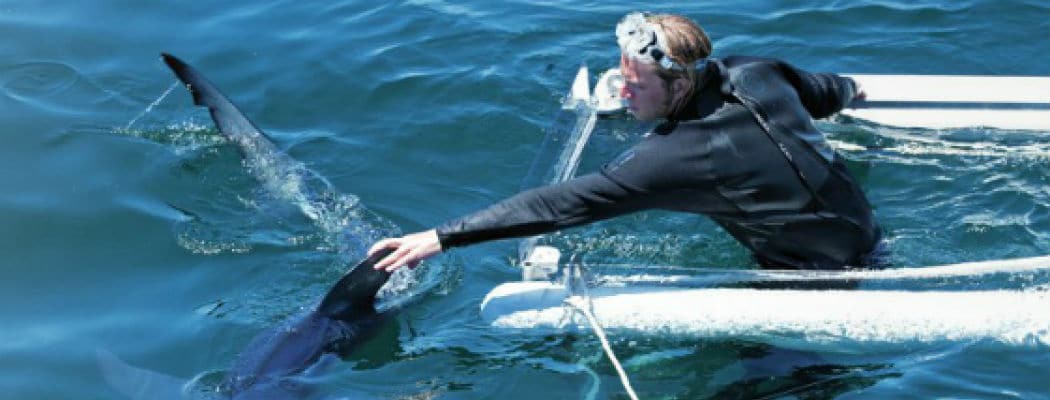“If a shark gets too close, wind up and punch it in the nose.”
 This is the first piece of advice I receive from Captain Bryce Rohrer of Nantucket Shark Divers — I hope it’s not the last. We’re ten miles south of Nantucket, 240 degrees southwest of Smith Point to be precise, in a location known as “The Owl.” The boat consists of the captain, a photographer, two boxes of chum, fifteen dead bluefish, and a four hundred pound shark cage. We are aboard the Tracker, a thirty-one-foot, ton-and-a-half diesel whose character far exceeds its beauty. The old trawler once fished the waters around Montauk. Now it chugs off the coast of Nantucket in search of big sharks — not to catch, but to swim alongside.
This is the first piece of advice I receive from Captain Bryce Rohrer of Nantucket Shark Divers — I hope it’s not the last. We’re ten miles south of Nantucket, 240 degrees southwest of Smith Point to be precise, in a location known as “The Owl.” The boat consists of the captain, a photographer, two boxes of chum, fifteen dead bluefish, and a four hundred pound shark cage. We are aboard the Tracker, a thirty-one-foot, ton-and-a-half diesel whose character far exceeds its beauty. The old trawler once fished the waters around Montauk. Now it chugs off the coast of Nantucket in search of big sharks — not to catch, but to swim alongside.
We are drifting in a spin off of the Gulf Stream, in about 130 feet of water. There is a whisper of wind coming out of the west, and the sea is flat calm, its temperature rising from sixty-two degrees to a tropical seventy-five. Captain Bryce is busy readying the shark cage to be dumped overboard. The cage appears more like a Plexiglas phone booth than the steel grid made famous by Jaws. Custom-built by legendary stuntman and inventor, Eddie Paul, the five- foot by six-foot cage is equipped with bulletproof glass and functions like a reverse aquarium. One element, however, sets the cage apart on this particular day. For the sake of getting the best underwater photography, a three-foot by two-foot window has been left open to the sharks. Normally, a diver would be completely enclosed and protected in the cage, but we opted for the window.
The cage splashes into the water gracelessly and is tied off at the stern. Captain Bryce starts chumming. He pours a three count of fish oil into the water, then hangs a chum bucket from the boat’s gunnel and starts fileting up bluefish. “Blues are the best for baiting sharks,” he says. “They’re oily, and they make up the majority of their diet out here.” The goal is to attract blue sharks, and if we’re lucky, a mako, what Captain Bryce describes as “pound for pound, the meanest, fastest, most aggressive fish in the water.” These are oceanic sharks, rarely if ever seen near land. Nantucket’s inshore shark population consists mostly of the sand tiger, sandbar shark, smooth dogfish, spiny dogfish and basking shark—all of which pose little to no threat to bathers. Here, some seventy miles from the Continental Shelf, all kinds of sharks are possible, from hammerheads to tigers to threshers to great whites.
Captain Bryce hangs two bluefish heads into the water, then stows the rest for later. “Chum is like alcohol for sharks,” he says while plucking meat off a filet and tossing it into the water. “You give them a little bit, and they’ll come to the party. You turn the water red, and they’ll go crazy.” He pauses and looks off. “Hopefully we can get them to swarm the boat.” As he is saying this, I am trying not to think about the wet suit I’m wearing or my intent to swim with these sharks. I am trying not to think about the eighteen-foot great white reported off Chatham yesterday, or the 990-pound mako caught off Block Island last week. I am trying not to think about the helicopter ride that would be my only chance of survival in the unlikely event of a serious attack. Instead, I am trying to think about my interview with Dr. Gregory Skomal a week before.
Greg Skomal is the top shark scientist in the Northeast, heading up the Massachusetts Shark Research Program for the Division of Marine Fisheries. When the Discovery Channel came to the Cape and the islands to film Jaws Comes Home for Shark Week two years ago, they called up Skomal. He’s without question the authority on sharks in New England. “Going out and encountering these animals in their natural environment, you will notice their beauty and their grace and their inquisitive nature,” Dr. Skomal said to me over the phone. “You’ll see that they’re not going to try to bite you.” He went on to explain that attacks are typically due to mistaken identity: the shark making an exploratory bite into what it senses to be prey. “We’re talking about animals whose sensory perception is exquisite, but we can’t think of them as being actually intellectual creatures,” he explained. “Environmental conditions don’t always allow them to make out the difference between a surfer on a surfboard and a seal on the surface.” When I informed Dr. Skomal that I was going to be diving with sharks off the coast of Nantucket, he responded just as everyone else I told: “Are you going with Bryce?”
 Twenty-seven-year-old Bryce Rohrer is the only shark diving guide on the Cape and the islands. His outfit, Nantucket Shark Divers, just launched this summer, offering clients of all ages the chance to experience sharks up close and personal. Bryce’s reputation for swimming with large sharks, however, started much earlier. Somewhere in the old Rohrer family album is a photo of an eight-year-old Bryce lifting a dead three-foot brown shark over his head. He has been obsessed ever since. At sixteen, Bryce entered the water with them, diving on hammerheads off the Galapagos Islands. After college, he spent months in South Africa, arguably the great white capital of the world, first serving as a great white research assistant and then as a shark diving guide. “I would take out ten to thirty people, and we’d be diving on fifty sharks…mostly tiger sharks and bulls,” he says. It was here in South Africa that Bryce observed shark behavior up close, learning to hand-feed them and read their movements. Swimming with packs of giant bull sharks all day, everyday, he also vanquished his fear of them. When first meeting Bryce, his appearance doesn’t strike you in that Captain Quint kind of way. He’s wearing a t-shirt, baggie shorts, and no hat or sunglasses. However, it doesn’t take long to realize that he is as salty as they get. “I want to go after the biggest, baddest things in the ocean,” he says without a hint of bravado, “and those are sharks.”
Twenty-seven-year-old Bryce Rohrer is the only shark diving guide on the Cape and the islands. His outfit, Nantucket Shark Divers, just launched this summer, offering clients of all ages the chance to experience sharks up close and personal. Bryce’s reputation for swimming with large sharks, however, started much earlier. Somewhere in the old Rohrer family album is a photo of an eight-year-old Bryce lifting a dead three-foot brown shark over his head. He has been obsessed ever since. At sixteen, Bryce entered the water with them, diving on hammerheads off the Galapagos Islands. After college, he spent months in South Africa, arguably the great white capital of the world, first serving as a great white research assistant and then as a shark diving guide. “I would take out ten to thirty people, and we’d be diving on fifty sharks…mostly tiger sharks and bulls,” he says. It was here in South Africa that Bryce observed shark behavior up close, learning to hand-feed them and read their movements. Swimming with packs of giant bull sharks all day, everyday, he also vanquished his fear of them. When first meeting Bryce, his appearance doesn’t strike you in that Captain Quint kind of way. He’s wearing a t-shirt, baggie shorts, and no hat or sunglasses. However, it doesn’t take long to realize that he is as salty as they get. “I want to go after the biggest, baddest things in the ocean,” he says without a hint of bravado, “and those are sharks.”
The water glistens with chum, and gulls and terns dive-bomb the surface for bluefish scraps. It’s time to get in. I spit into my goggles, drag them over my scalp, put the snorkel into my mouth, and swing my legs over the gunnel. Here we go. Just get in. Just get in. JUST GET IN. I plunge over the side, and swim spiritedly to the cage and in through the open photography window. Steadying myself into a corner, the cage raps against the transom in the lapping current. Before long, the captain calls out: “Alright, we have a shark just off the stern to the left.”
I dip below the surface and walk my hands down the cage, my breath panting in my ears through the snorkel. This is the moment I feared most, searching the green abyss, waiting for the first sign of the shark, completely unsure how I would respond when it swam into sight. And then there it is, moving through the water like a length of silk in a light breeze.
Entering into a beam of sun, the shark explodes in magnificent blue—a blue shark, about six feet long, with an old fishing leader trailing from its mouth. I notice something splash in the water and see that it is a bluefish carcass tied to a line—Captain Bryce is teasing the shark to the cage. The shark glides lazily to the bait, Bryce luring him closer and closer to the cage. Six inches from the glass, the bait stops. The shark opens its mouth, revealing its teeth, and white caps roll over its black eyes. It snips the hunk of bluefish in half like scissors through construction paper.
For twenty minutes, the shark circles the cage, lingering by the open window and peering at me with dancing eyes. My fear is gone, replaced by excitement and a genuine appreciation for this animal’s perfect, prehistoric design. Its sleek body is a composite of beveled lines, hewn by evolution and culminating in sheer hydrodynamic power. For most people, sharks occupy a part of the brain connected to fear. Yet, it’s a fear rooted in Hollywood fictions, imagination, and dead, toothy sharks hung up on the dock. Seeing the shark in real life, how it slips through the water curiously, dispels the malicious, man-eating image I long held.
 Even in the seventy-five degree water, a chill takes hold of me and I exit the cage. It’s now my photographer Kit Noble’s turn to enter and hopefully capture some underwater images. Just before he dives in, Captain Bryce stops him. “Where did you get those?” he asks, nodding to the Kit’s yellow-rimmed goggles. “They’re mine. I brought them with me.” “Sharks love yellow,” the captain says. “We call it ‘yummy yellow.’ Keep that camera in front of your face.” Kit drops into the water, apparently satisfied with this solution.
Even in the seventy-five degree water, a chill takes hold of me and I exit the cage. It’s now my photographer Kit Noble’s turn to enter and hopefully capture some underwater images. Just before he dives in, Captain Bryce stops him. “Where did you get those?” he asks, nodding to the Kit’s yellow-rimmed goggles. “They’re mine. I brought them with me.” “Sharks love yellow,” the captain says. “We call it ‘yummy yellow.’ Keep that camera in front of your face.” Kit drops into the water, apparently satisfied with this solution.
Before long, a bigger blue shark glides onto the scene. It’s eight feet long, and far more energetic and bold than the one before. “We got a player,” Captain Bryce mutters. The photographer bounces from wall to wall, snapping away for the money shot with his underwater camera. When the shark swims off, we call out its location and Kit comes to the surface to check out his shots. “We need to bring him closer to the window,” he says, scrolling through the last series of images. “The water is too murky. We need to get the shark closer.” Bryce casts out a fat filet, and brings the shark right to the open window. Kit wedges himself into the bottom corner of the cage and fires away. Then something completely unexpected happens.
The shark enters the cage.
The moment unfolds in torturous slow motion. Realizing that it’s in the cage, the shark turns to get out, enveloping its entire body in the cage with Kit. Bryce reaches for the gaff, but before he can grab it, Kit starts delivering hammer fists to the eight-foot shark. The shark flails, twisting itself to find the opening in the cage. One more hit to the side, and the shark explodes out the open window. Kit darts to the surface, climbing to the top of the cage frantically—except he’s not cursing or yelling, but laughing. Hysterically. “I think that was close enough!” he yells, throwing his head back in disbelief. “It wasn’t threatening. It just wanted to get out of the cage.” Kit stays in the water for another three sharks, and we get our shot.
Beyond the sheer rush of the experience,diving with sharks aboard Captain Bryce Rohrer’s Tracker illustrates some important points. For one, sharks are not interested in, or in search of humans as prey. It took two buckets of chum, fifteen bluefish carcasses, a bottle of fish oil, a highly knowledgeable captain, and motoring two hours offshore to raise five sharks that would dart away with a tap on the nose. This is not to say jump in the water whenever you see a dorsal fin. These are powerful, instinctive animals that can literally sense fear.
Today, the stigmas surrounding sharks are being reconsidered. “There was a time, maybe fifty years ago, that the only good sharks were dead sharks,” Dr. Skomal said to me during our interview. “In the last ten to fifteen years, there has been a changing attitude, a lot of people have tremendous respect for them and believe them to be important components of our ecosystem.” Nevertheless, Captain Bryce says that sharks continue to be fished aggressively: “The scary thing is that in fifteen years, we might not be able to do this.”
With the cage plucked from the water and brought on board, Captain Bryce fires up his diesel engine and we embark on the two-hour steam back to Nantucket. The photographer and I sit in the sun, reeling from adrenalin hangovers, smiling and speechless. The images of the day play over my mind, and I can sense that a fundamental shift has occurred. Like lions and tigers and bears, sharks encapsulate the dichotomy of man and beast. They are source of fear and fascination, patrollers of a watery world we both embrace and repel. Yet in the water, a shark is just another animal searching for food and trying to survive. In all likelihood, man’s fear of sharks will never be quelled. But hopefully, in time, that fear will also breed better understanding and respect for these magnificent creatures.
THE GREAT WHITE QUESTION
With Nantucket’s growing abundance of seals, many are concerned that the waters around the island could soon become a haven for great white sharks, as seen recently off Chatham and Monomoy. For more insight on this concern, we turned to leading shark expert Dr. Gregory Skomal. “We know the white shark occurs around Nantucket and all of New England, really,” Dr. Skomal explained. “It’s highly plausible that Nantucket — specifically those areas of Nantucket that have high seal abundance— may be suitable for white sharks.” Dr. Skomal indicated that in addition to Great Point last year, which witnessed a large white shark in the area, Muskeget Island (located just west of Nantucket) is another plausible location for a white shark population. “It’s an area that is remote and there’s lots of seals on it. If everything plays out as it should, then there should be lots of white sharks around that island,” he said. “But one thing about Muskeget is that it’s very shallow. And there are lots of shoals and sandbars and it’s not easy access for animals that don’t want to be in shallow, shallow water. So Muskeget may never become a white shark hotspot…but that’s a question we are trying to answer.” Skomal said swimmers should take comfort in the fact that seal populations are less dense in highly trafficked and populated shorelines, thus also deterring great whites.






